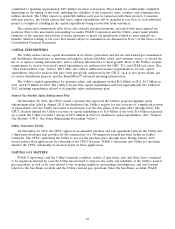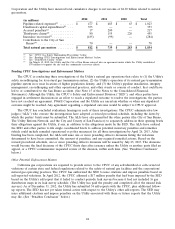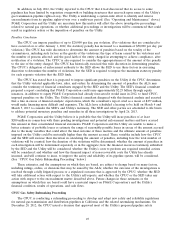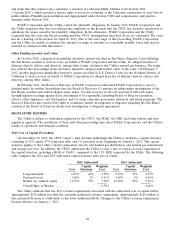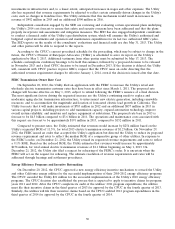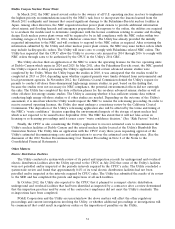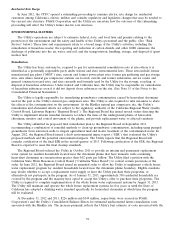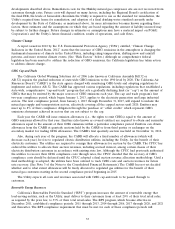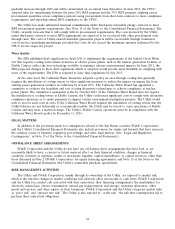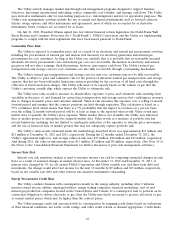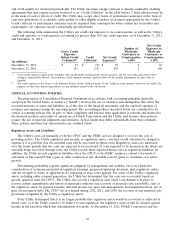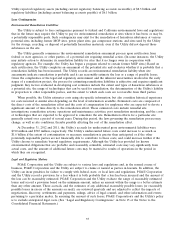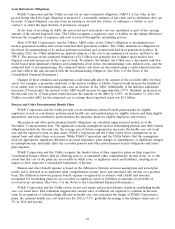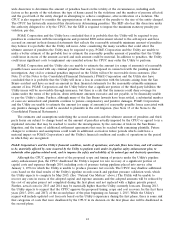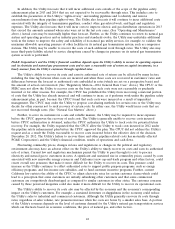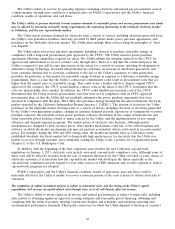PG&E 2012 Annual Report Download - page 37
Download and view the complete annual report
Please find page 37 of the 2012 PG&E annual report below. You can navigate through the pages in the report by either clicking on the pages listed below, or by using the keyword search tool below to find specific information within the annual report.developments described above. Remediation costs for the Hinkley natural gas compressor site are not recovered from
customers through rates. Future costs will depend on many factors, including the Regional Board’s certification of
the final EIR, the levels of hexavalent chromium the Utility is required to use as the standard for remediation, the
Utility’s required time frame for remediation, and adoption of a final drinking water standard currently under
development by the State of California, as mentioned above. As more information becomes known regarding these
factors, these estimates and the assumptions on which they are based regarding the amount of liability incurred may
be subject to further changes. Future changes in estimates or assumptions may have a material impact on PG&E
Corporation’s and the Utility’s future financial condition, results of operations, and cash flows.
Climate Change
A report issued in 2012 by the U.S. Environmental Protection Agency (‘‘EPA’’) entitled, ‘‘Climate Change
Indicators in the United States, 2012’’ states that the increase of GHG emissions in the atmosphere is changing the
fundamental measures of climate in the United States, including rising temperatures, shifting snow and rainfall
patterns, and more extreme climate events. (See ‘‘Risk Factors’’ below.) Although no comprehensive federal
legislation has been enacted to address the reduction of GHG emissions, the California legislature has taken action
to address climate change.
GHG Cap-and-Trade
The California Global Warming Solutions Act of 2006 (also known as California Assembly Bill 32 or
AB 32) requires the gradual reduction of state-wide GHG emissions to the 1990 level by 2020. The California Air
Resources Board (‘‘CARB’’) is the state agency charged with monitoring GHG levels and adopting regulations to
implement and enforce AB 32. The CARB has approved various regulations, including regulations that established a
state-wide, comprehensive ‘‘cap-and-trade’’ program that sets a gradually declining limit (or ‘‘cap’’) on the amount of
GHGs that may be emitted by the major sources of GHG emissions each year. The cap and trade program’s first
two-year compliance period, which began January 1, 2013, applies to the electricity generation and large industrial
sectors. The next compliance period, from January 1, 2015 through December 31, 2017, will expand to include the
natural gas supply and transportation sectors, effectively covering all the capped sectors until 2020. Emitters may
meet up to 8% of their compliance obligation through the purchase of ‘‘offset credits’’ which represent GHG
emissions abatement achieved in sectors that are not subject to the cap.
Each year the CARB will issue emission allowances (i.e., the rights to emit GHGs) equal to the amount of
GHG emissions allowed for that year. Emitters (also known as covered entities) are required to obtain and surrender
allowances equal to the amount of their GHG emissions within a particular compliance period. Emitters can obtain
allowances from the CARB at quarterly auctions held by the CARB or from third parties or exchanges on the
secondary market for trading GHG allowances. The CARB’s first quarterly auction was held on November 14, 2012.
Also, during each year of the program, the CARB will allocate a fixed number of allowances (which will
decrease each year) for free to regulated electric distribution utilities, including the Utility, for the benefit of their
electricity customers. The utilities are required to consign their allowances for auction by the CARB. The CPUC has
ordered the utilities to allocate their auction revenues, including accrued interest, among certain classes of their
electricity distribution customers in accordance with existing state law. Although the CPUC had previously authorized
the utilities to recover their GHG compliance costs through rates, the CPUC decided that the recovery of GHG
compliance costs should be deferred until the CPUC adopted a final auction revenue allocation methodology. Until a
final methodology is adopted, the utilities have been ordered to track GHG costs and auction revenues for future
rate recovery. (See Note 3 of the Notes to the Consolidated Financial Statements.) The CARB has not yet decided
whether and to what extent allowances will be freely allocated to regulated gas utilities for the benefit of their
natural gas customers starting in the second compliance period beginning in 2015.
The Utility expects all costs and revenues associated with GHG cap-and-trade to be passed through to
customers.
Renewable Energy Resources
California’s Renewables Portfolio Standard (‘‘RPS’’) program increases the amount of renewable energy that
load-serving entities, such as the Utility, must deliver to their customers from at least 20% of their total retail sales,
as required by the prior law, to 33% of their total retail sales. The RPS program, which became effective in
December 2011, established compliance periods: 2011 through 2013, 2014 through 2016, 2017 through 2020, and 2021
and thereafter. The RPS compliance requirement that must be met for each of these compliance periods will
33


